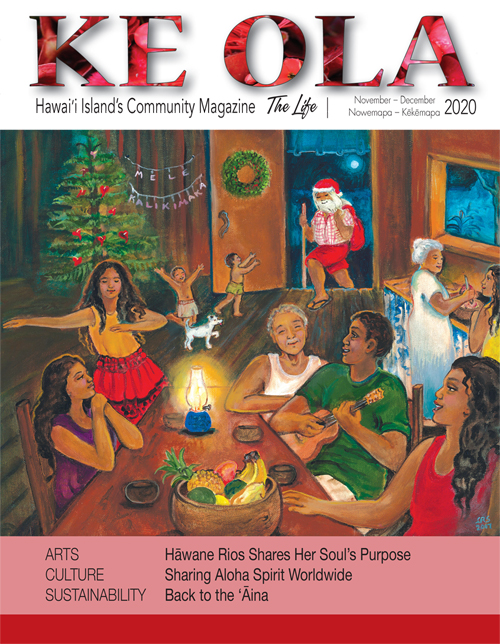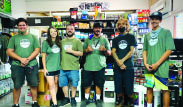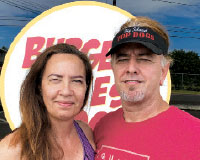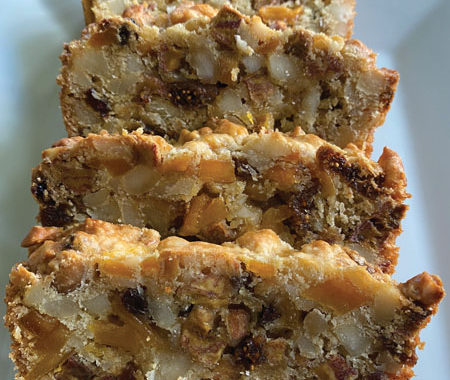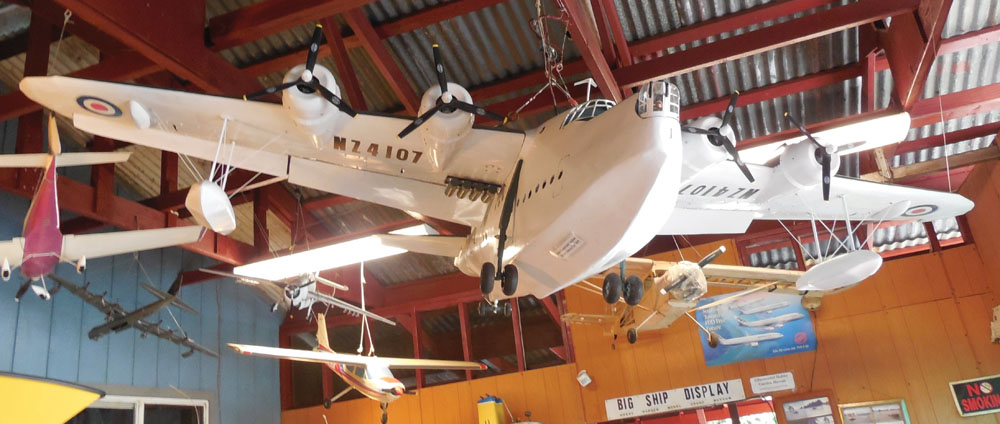
Hobby Garden: A Happy, Sustainable Learning Center
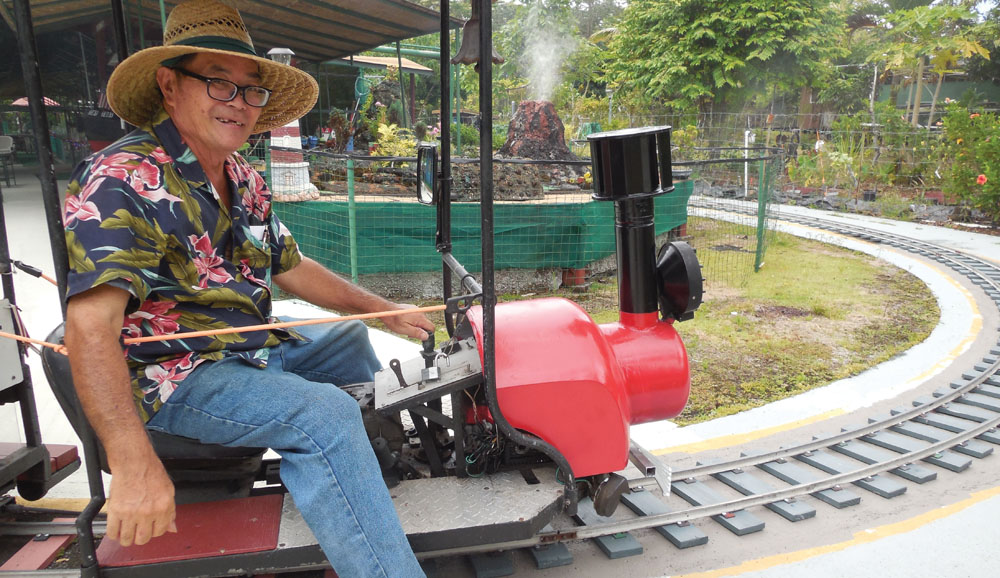
By Stefan Verbano
Every other day, the big four-engine seaplanes would roar over Johnson Lum’s grandfather’s home on the main Fiji island of Viti Levu. The Sunderland Flying Boats were on rescue and reconnaissance missions over vast, isolated stretches of the Pacific Ocean, operating out of an air base at Laucala Bay near the capital city, Suva. Johnson lived with his family just a few miles away.
The sight and sound of the World War II-era British plane, with its broad belly and more than 100-foot wingspan, sparked a burning desire in Johnson’s impressionable six-year-old mind to become a master of machines someday. It was what set him on the path to be a self-taught engineer, who now, at 66, happily surrounds himself with anything that has a motor and moves. He spends his days constantly tinkering away at his verdant home-turned-amusement-park in East Hawai‘i. Many years after those formative moments in Fiji, Johnson finally built a Sunderland “flying boat” of his own—albeit one-tenth the size—from fiberglass and wood, covered in a skin of thin aluminum sheets and painted to look like the real thing.
Johnson’s model Sunderland hangs from the ceiling and forms the centerpiece of what he calls “The Wow Room,” a museum-like showroom of plexiglass display cases full of every imaginable sort of model machine, including planes, cars, trucks, tanks, sailboats, steamships, rocket ships, and much more. Everywhere there are Hot Wheels treasure chests, painstakingly arranged everywhere. The room, named after the excited exclamations made by wide-eyed visiting schoolchildren, is just one piece of Johnson’s life’s work: “The Hobby Garden”—his and his wife’s home-based, family-friendly amusement park located in Hawaiian Paradise Park that is part science fair, part petting zoo, part museum, and part teaching farm.
Hobby Garden has everything: songbirds, tortoises, rabbits, ball games, cultural dioramas from around the world, a tabletop concrete volcano with built-in fog machine, homemade seaworthy boats, a fishpond teeming with fish, rods with barbless hooks for kids to catch them with, and a working, rideable model train that loops through it all. Johnson is its conductor, and drives the mini-locomotive along a narrow track running atop thousands of hand-laid, hand-painted wooden railroad ties.

Within the massive fishpond, koi, tilapia, midas, and an imposing dark grey South American Amazon fish called the red belly pacu, crowd each other at the bank, fighting over dry catfish food which gets tossed out in generous handfuls. The 150,000-gallon pond contains thousands of tilapias, some for eating and some for selling to local aquaponics enthusiasts. Standing on the covered lānai adjacent to the pond, leaning on the childproof railing as he pitches out feed, Johnson spots a particularly large pacu at the surface—a fish that can be three feet long and weigh more than 50 pounds full-grown. “No oneʻs supposed to catch that fish,” he says, chuckling to himself. “It would break the pole.”
Surrounding the pond are fruit trees of every type—breadfruit, avocado, soursop, citrus, papaya, Brazilian cherry, and sapote. Whatever food from the land Johnson and his wife can’t eat becomes compost to feed the fish, and periodically the two work together to fertilize the surrounding plants with sediment-rich water pumped from the pond. To Johnson, this is real sustainable farming.
“I can eat the fish, I can eat the fruit,” Johnson says. “They feed each other. Just like this, itʻs already sustainable.”
A fruit tree nursery takes up one corner of Hobby Garden’s grounds, functioning in a similar way to the fishpond; some of the saplings Johnson and his wife Yamna transplant as food for their own kitchen, and some they sell for extra income. They make a good team—Johnson helping customers select trees from the nursery, Yamna hanging back with a clipboard and calculator noting each treeʻs price, adding up the total, handling cash and giving change.
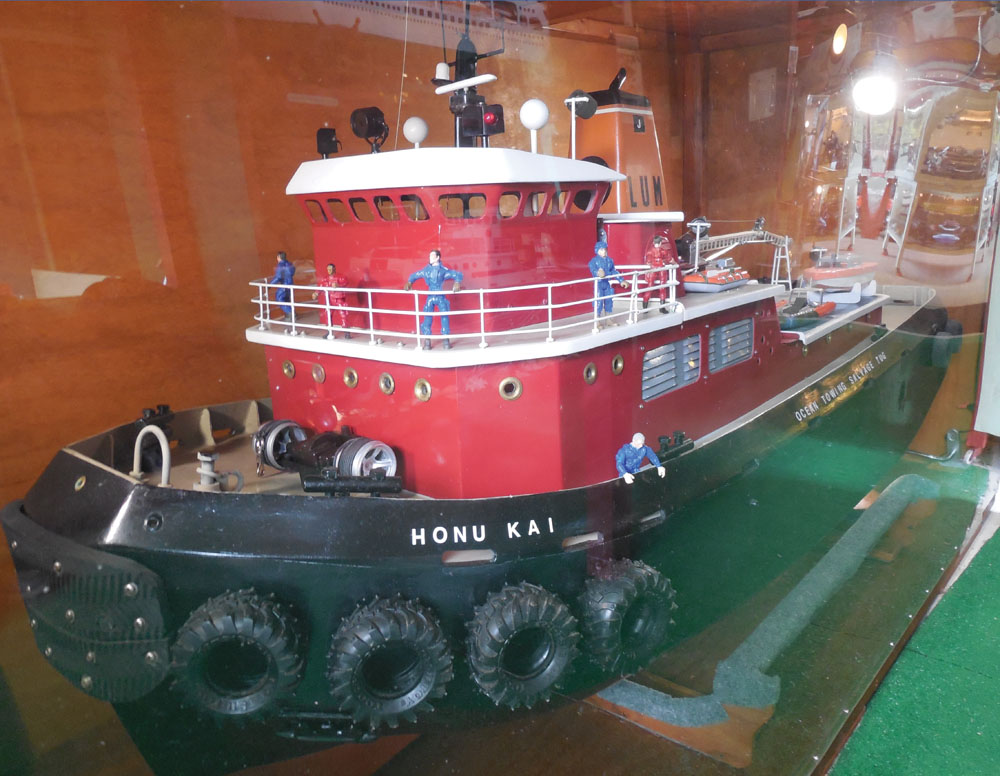
Johnson’s Secret Recipe for Learning
Everywhere around Hobby Garden there are education stations. Trees in the orchard have wooden placards slung around their trunks listing their common names. Laminated signs posted around the edge of the fishpond include pictures and short descriptions for each of the species that can be seen sloshing away below.
Just inside the park’s front entrance is its “solar power experiment station,” a small solar panel mounted to a table at an angle facing the sky, wired through a homemade switchboard to power a series of small gadgets: electric fans and electric motors mounted around the table that buzz and whirl on interminably on clear days. At this station, Johnson is again tour guide, and with a well-rehearsed move he raises his arms up over the panel to block the sunlight. The buzzing and whirling stops. “Kids will get it immediately,” he says with a grin.
At Hobby Garden, it seems heʻs found the secret recipe for getting kids interested in learning: draw them in with the flashy, whizz-bang stuff, and then teach them some real knowledge on the side while theyʻre being entertained. “Education has got to be a part of it, otherwise itʻs a waste of time—a waste of ideas,” Johnson says.
Amidst the boats and planes and trains and smoking volcanos inhabiting Hobby Garden are a million opportunities to learn about anthropology, biology, physics, engineering, and world history. An entire quadrant of the garden is filled with cultural dioramas depicting scenes of everyday life from various continents and time periods. Thereʻs the Great Wall of China interspersed with heaps of Chinese artifacts, next to a replica of the Eiffel Tower and a scene of French culture, along with models of the White House, the Golden Gate Bridge, the Statue of Liberty—even an outer space moonscape scene with astronauts and rovers.
At one end of the avenue of cultural dioramas, a Polynesian exhibit includes the fog-machine volcano whose lava-textured pāhoehoe (smooth, ropy lava) Johnson formed by squeezing wet cement out of an icing bag—a nod to his original occupation in Fiji as a baker and pastry chef. There’s also a tabletop replica of the ancient Hawaiian division of land known as the ahupua‘a, complete with taro patches draining into a spiral fish pond, a pig cooking in an imu (a traditional Hawaiian earthen oven), and a row of handsomely built model outrigger sailing canoes.
When Johnson is out and about in town, people call him “Hobby Garden Guy.” No doubt heʻs known by the same moniker among Hawai‘i Island’s schoolchildren, who visit the garden on field trips.
“They are so happy to be here,” Johnson says about the visiting keiki. “When itʻs time for them to go home they sing a song to me. Thatʻs a big reason why I keep this going: to bring them that joy.”
Another crowd of perennial garden guests has been visitors to the island, who would be hard-pressed to find a competing amusement park with this level of flair. Johnson keeps a large rectangular cookie tin around the reception area, and itʻs full of feedback forms written by people from faraway places like Japan, Germany, and Russia—papers peppered with exclamation points, smiley faces, and hearts.
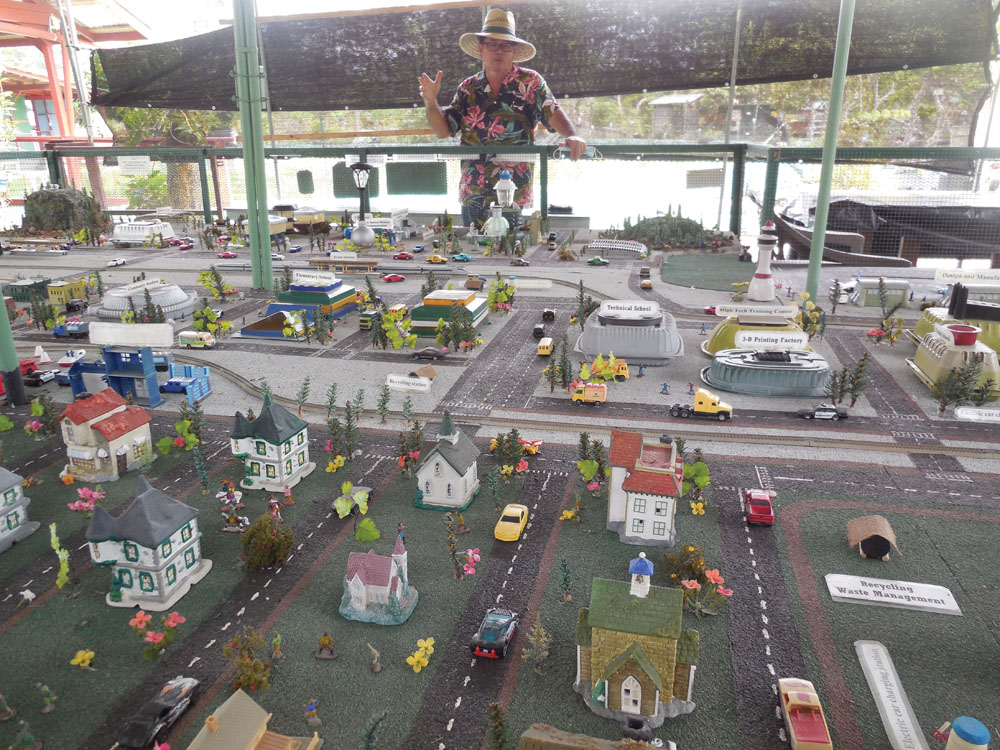
Johnson’s Vision of a “Happy Sustainable City”
In the afternoon heat, Johnson takes a break from his rounds and slouches in a plastic lawn chair on the fishpond lānai, his sun hat resting on his belly. He starts to talk about his “Happy Sustainable City” model—another intricately designed diorama he started in 2015 which takes up a different corner of Hobby Garden. This model is a sprawling tabletop grid of tidy houses, schools, commercial and industrial buildings, farmland, nature parks, utilities infrastructure, and everything else needed to make his vision of a green utopian society function, all of it made from everyday household items.
There is no crime, no civil strife, no hunger, and no homelessness in the Happy Sustainable City. Instead of a police force, thereʻs a team of “community advisers,” and a regular work day for residents is only six hours long. Food production is completely self-sufficient with the help of sustainable farming innovations. Electricity for the city comes from what Johnson calls a “water battery,” a continuous energy generation system where water is pumped uphill into a holding tank through massive pipes using solar power during the day, and then released at night to slowly drain down again, turning turbines built into the pipes as it falls, generating electrical current until next sunrise.
“50 to 80 percent of the bad things in society would be gone if we lived like this,” Johnson says about his utopian metropolis. “If we franchise this all over the world, we could change the world in three generations.”
At first glance, it may seem like just another curious tabletop diorama, all within an amusement park overflowing with so many miniatures. But to Johnson it represents a real-world solution, formulated over a decade of sociological study, relying on modern technology and a traditional Polynesian communal work ethic.
“If you give people good direction—a pathway where theyʻre happy, theyʻre content,” Johnson says, “When they have food and a job, then they know they donʻt need to be mischievous.”
Hobby Garden is located at 15-1695 12th Avenue, Hawaiian Paradise Park, Kea‘au. ❖
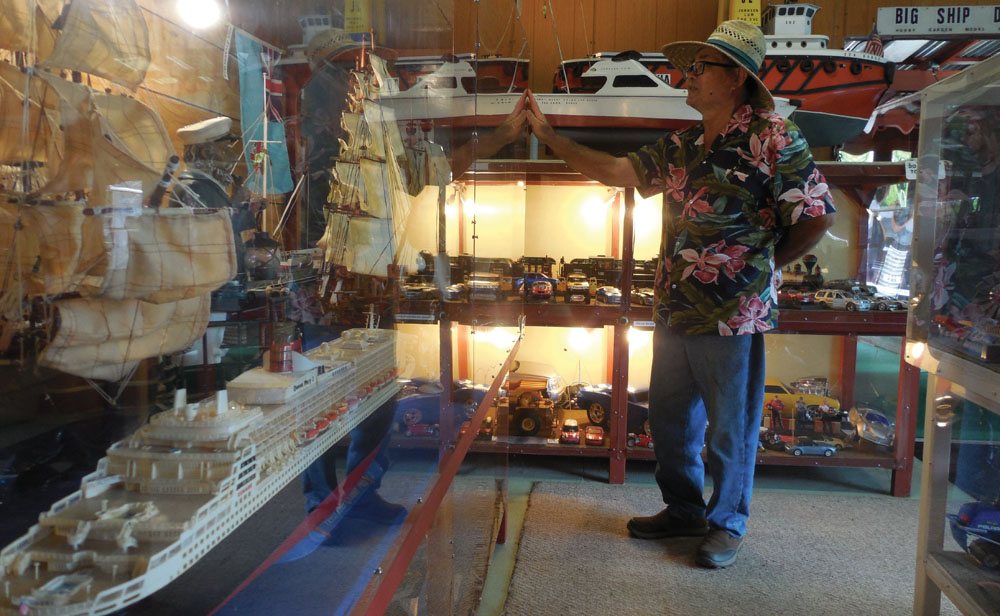
For more information about Hobby Garden’s exhibits, admission pricing, and updated social distancing and sanitation rules: 808.982.5604
